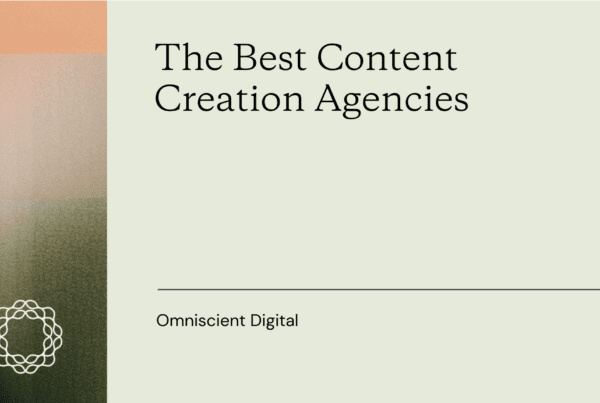
In enterprise content marketing, the main challenge is getting out of your own way.
Startups face other challenges; namely, they’re facing an uphill battle against incumbents with larger audiences, stronger websites, and established brands.
We cover those content strategy challenges effectively in our articles on content economics and the barbell strategy.
Instead of rehashing the basic stuff (like mapping out your key content marketing metrics, building a growth model, and writing good content), I want to write a piece on the most pressing issues I see for enterprise companies.
This will primarily cover B2B content marketing, but it can apply to B2C content marketing as well.
The Key Differences Between Enterprise Content Marketing and Startup Content Marketing
After working with several dozen clients of all sizes on content marketing and SEO, plus working in-house on growth, content, experimentation and demand gen at companies ranging from pre-seed to public enterprises, here’s what I can tell you:
Startups and scaleups struggle against external obstacles to success; incumbents and enterprises struggle with internal roadblocks.
Even with all the advantages, economically and otherwise, large enterprises often die from self-inflicted wounds.
These largely come in the form of organizational inertia, lack of innovation and risk-taking, and slow pace and iteration due to red tape and process bottlenecks.
Enterprises benefit from the compounding effects of a strong brand. Because they’ve already got a strong website, content they write is more likely to rank (all things equal).
They attain backlinks passively (startups have to beg, plead, and buy links).
They already have an audience and an email list to launch to. They don’t suffer the “tree falls in a forest problem,” and they rarely have to think too hard about content distribution.
Yet, in my personal career, I’ve been on a small marketing team of 2 that outpaced teams with dozens of people. We would write at least 5 posts per week when the competition would struggle to ship 2 per week. We would double our traffic as our competitors would stagnate.
Why?
A few reasons (and solutions to follow):
- The company lacks a north star goal
- Red tape and process is slowing your throughput
- Lack of boundaries is wasting resources
- Attribution systems don’t showcase results properly
- Your “brand voice” is hamstringing potential results
- Your library needs maintenance
6 Enterprise Content Marketing Mistakes (and How to Fix Them)
1. The company lacks a north star goal
Large companies usually (but not always) have a content marketing strategy that works; or at least, it worked up to a point. The basics are in place. You know your target audience. You know what “quality content” looks like.
Usually, as a company scales, the content marketing strategy starts to proliferate into multiple goals (sometimes competing).
With a single, centralized content marketing team, it becomes difficult to align your vectors, narrow your focus, and move the needle toward any one of these goals.
For example, lead generation goals may warrant gated content like webinars, white papers, and case studies. SEO goals obviously aim toward organic traffic. Executives may also want to increase brand awareness and experiment with different formats like LinkedIn, podcast, infographics and mixed media efforts that require an integrated content marketing campaign.
The content team can and should invest in different marketing efforts, but if one dilutes their efforts across many different goals, it’s easy to lose sight of the prize.
Solution: create a growth model, determine your core content KPIs, and establish a content “portfolio”
The first step to successfully scaling your content marketing is defining your objectives and key results (OKRs) early on and redefining them as you scale.
What are your goals? What does success look like? Answering these questions will help you develop a clear plan of attack and make it easier to measure your progress along the way.
Without a clear understanding of your goals, it will be difficult to determine whether or not your efforts are paying off.
More importantly: which content marketing metrics are you willing to sacrifice in pursuit of your core goals?
Tradeoffs are inherent to strategy. Get your executives and key stakeholders in a room and get agreement on what matters right now, what your future horizons look like, and what you will focus on.
As for competing priorities, you don’t have to only focus on one type of content. Instead, you can build a content portfolio.
Perhaps 80% of your portfolio is designed to rank in the search engine. 10% is for product marketing, and 10% is experimental and brand focused.
Your portfolio will depend on your unique circumstances, but planning this helps you operate within the guardrails of your goals and resource limitations.
Creating a growth model can help you figure out which playbook to run.

2. Red tape and process is slowing your throughput
Processes and systems help you scale. No doubts about that.
Standardizing stuff like content briefs, style guidelines, and your content roadmap allow you to produce content faster, with greater attention to detail.
However, many large companies overdo it. “Process is safety,” as Benyamin Elias wrote.
It’s necessary to build systems, but you have to be careful that you don’t wind up with a bloated system that eliminates progress in favor of standardization. Ask yourself, “are there errors I can live with if it allows us to make progress faster?” Strategy (and process) involves tradeoffs.
Solution: re-org to facilitate efficiency and audit your process to uncover process bloat.
As your operation scales, you’ll need to create templates and systems that allow you to work efficiently while maintaining quality control.
For example, developing standardized templates for blog posts, email newsletters, and social media updates will save you time in the long run while still ensuring that all of your content meets brand guidelines.
Additionally, creating systems for managing feedback and revisions will help you keep track of changes and ensure that everyone is on the same page. Defining your workflow also makes it easier to onboard new employees.
But process can often get in the way of results. Worse yet, it can often hamstring your top performers by turning them into checklist operators.
Outside of taking an honest look at your processes (which is hard to do objectively), I like to create huge, almost infeasible projects to see where things actually break and where process just gets in the way.
For example, at Omniscient, we created “Project 100,” where our small team published 100 blog posts in one month. This allowed us to figure out how to leverage tools and resources to speed up production, but it also helped us look at what rituals were actually a waste of time. Do we need 3 rounds of edits to go live? Do we need our full content briefs? What’s the minimum viable process?
Your minimum viable process will depend a lot on your company culture as well as regulations (healthcare and finance obviously having more external guardrails). But it’s important to question this stuff every now and again.
3. Lack of boundaries is wasting resources
My co-founder Allie recently wrote a great newsletter rant based on a chat she had with a client.
One of the team’s content writers mentioned a pain point: he and his team often receive content ideas and “assignments” from leadership, making it difficult for them to stick to a consistent content strategy.
He felt pulled in multiple directions and, sometimes, taken advantage of. Moreover, because the assignments were from VPs and C-suite, they were subject to multiple rounds of revisions, slowing down his publishing cadence.
This is incredibly common.
In some organizations, content teams are susceptible to being treated as second-class marketers, or put more positively, as centers of excellence that lend their resources to many other teams like product management, product marketing, demand generation, brand marketing, and paid acquisition.
While collaboration is great, it’s important to set up boundaries and protect your time and goals to make sure you’re generating positive ROI.
Solution: create an intake form and empower your team to set boundaries based on KPIs
An easy thing to do: create a topic submission form
At HubSpot, the content team was hounded with folks looking to leverage our big writing team (I was one of those people hounding the content team).
The head of content created a simple yet effective Google Form to capture topic submissions. They shared that form in Slack, on the internal Wiki, and at the end of their monthly reporting calls. It was a helpful way to distill external ideas and force folks to think about the what and why before sending projects their way.
The other thing you can do is establish and work from a content roadmap (or content calendar).
Once you’ve defined your OKRs, it’s time to start building a strong foundation for your content operation with a robust content calendar.

This calendar should be designed to keep all of your content creation and distribution efforts organized and on track. To do this effectively, you’ll need to involve stakeholders from across the organization, including editorial, design, marketing, sales, and product. By aligning all of these teams from the outset, you’ll avoid potential roadblocks down the line.
Get everyone on board, agree on a direction, and then work on execution. I like to establish a quarterly cadence to groom the backlog and iterate on direction.
4. Attribution systems don’t showcase results properly
You’d think that enterprise content marketing strategy would benefit from increased visibility and measurement potential. After all, you’ve got more budget, technology, and tools for content measurement.
However, I’ve seen the opposite. As systems get more complex, it becomes harder and harder to attribute value to any individual touchpoint.
When you’re a small team working toward a simple goal like lead generation, it’s easy to get an approximate value. As things scale and you invest in tons of new channels, things get murkier.
This isn’t just a problem for your own enterprise content marketing strategy and the decision you make, but it also poses a problem when it comes to getting increased investment and buy-in. You have trouble reporting your results and ROI, and when the economy declines or when tough decisions need to be made, content is first on the chopping block.
Solution: measure, report, and evangelize your efforts
The solution here is to become numerate and a bit “mathy.”
While you’ll never be able to measure all the benefits of content marketing, make sure that you can draw a straight line between your efforts (your content marketing costs and inputs) and your program KPIs (the outcomes).

Outside of this, you’ll need to evangelize the work you’re doing.
While content is not a tangible product, it can still be used to sell and influence stakeholders. It’s also important to remember that content should never exist in a silo — make sure you have a feedback loop built into your content marketing strategy so that content creation efforts are agile and the team can adjust direction quickly.
By making sure you have an attribution system in place and by evangelizing content marketing’s potential, you’ll be able to make sure content doesn’t get cut when the time comes for budgeting.
5. Your “brand voice” is hamstringing potential results
There should be a rule named after this phenomenon. The size of an organization directly correlates to its rigidity of brand guidelines.
Brand guidelines, like any form of standardization, serve a purpose. You can’t just post willy-nilly at a certain size; you have to maintain consistency and integrity in messaging, style, and voice.
However, in most cases, I’ve seen this rigidity hurt more than help.
For instance, at a past company I worked at (a HUGE player in the content world), there was a reluctance to write product-led content. The content team literally wouldn’t mention the company’s own products in their content. They would write product listicles and completely leave out their own product.
This made no sense to me, but it was in their brand guidelines to “avoid being sales-y.”
This is one of those things that, at a high level, makes sense. But it clearly prevented a ton of revenue from being made. So slowly, piece by piece, I chipped away at that facade, and we ended up producing hundreds of product-led pieces that drove thousands of product signups.
Another problem with brand voice is it often becomes so buttoned up as to lose any semblence of personality and voice.
Even the New York Times allows journalists their own personal flair and brand. People like following people. The worst example I see of this is when company blogs don’t allow personal bylines.
Solution: allow experimentation and question your assumptions
The solution here is to strike a balance between standardizing your brand image while giving your team the freedom to express their creativity. Develop flexible guidelines that allow for experimentation, and let your team try different approaches.
You should also constantly be questioning whether or not there are better ways of doing things. Don’t be afraid to change course if something isn’t working—your content should be constantly evolving to better serve the needs of your readers.
Finally, don’t forget that people like following personalities—so find ways to make sure your team members are included in the conversation. With these strategies in place, you’ll be able to achieve results while still maintaining a consistent brand image.
Think, too, about the user experience of guest writers and new employees. Are they really going to follow (let alone read) a 30 page style guide? Probably not.
6. Your library needs maintenance
Enterprise companies have an interesting problem. In many cases, they’ve already produced hundreds if not thousands of pieces of content.
Whenever I do a content audit for a prospect or client, and I see a huge library of untapped opportunities, I get excited.
It’s almost always easier to update old content than it is to write net new content. Not that content creation and its impact should be neglected (I already talked about increasing velocity).
But you’ve already invested the time and money into creating a library of good stuff, so you might as well squeeze more results (traffic or conversions) from it.
Because teams are incentivized many times merely by output and not outcomes, content optimization is forgotten. The best teams and companies I’ve worked for have had either dedicated in-house employees working on content optimization or supplemented with outsourcing this to agencies. Some, those with fewer resources and headcount, do a content audit and optimization sweep once per quarter.
Solution: incorporate a content optimization practice
The solution here is simple but not easy: incorporate a content optimization practice.
Set aside some resources and time to do quarterly audits. Have someone dedicate their efforts solely to the task of optimizing existing content.
This doesn’t mean they need to rewrite every piece of content, but they should identify pieces that are performing well and those that could use some love in terms of keyword optimization and product calls-to-action.
By doing so, you can squeeze even more traffic, leads, and conversions from the content you have already created. Plus, it will free up your team to focus on creating new content instead of worrying about optimizing old pieces.
Finally, don’t forget that tracking the performance of your content through analytics is critical.
Without it, you can’t possibly know what works and what needs to be improved. So make sure you have tracking set up and that you’re regularly reviewing the data. That way, you can ensure your content optimization efforts are actually making a difference.
Conclusion
Scaling an enterprise content operation is no small feat.
However, by following the tips above—defining your OKRs early on, building a strong foundation with a robust content calendar, creating templates and systems for efficiency (but not overdoing it)—you can set yourself up for success.
Additionally, investing in technology and automation tools will help you manage increased workloads without sacrificing quality or adding headcount.
The main thing is cultural: you have to get our of your own way. You have all the advantages of scale; but don’t let the complexity and bloat tie you down and let scrappy startups surpass you.




